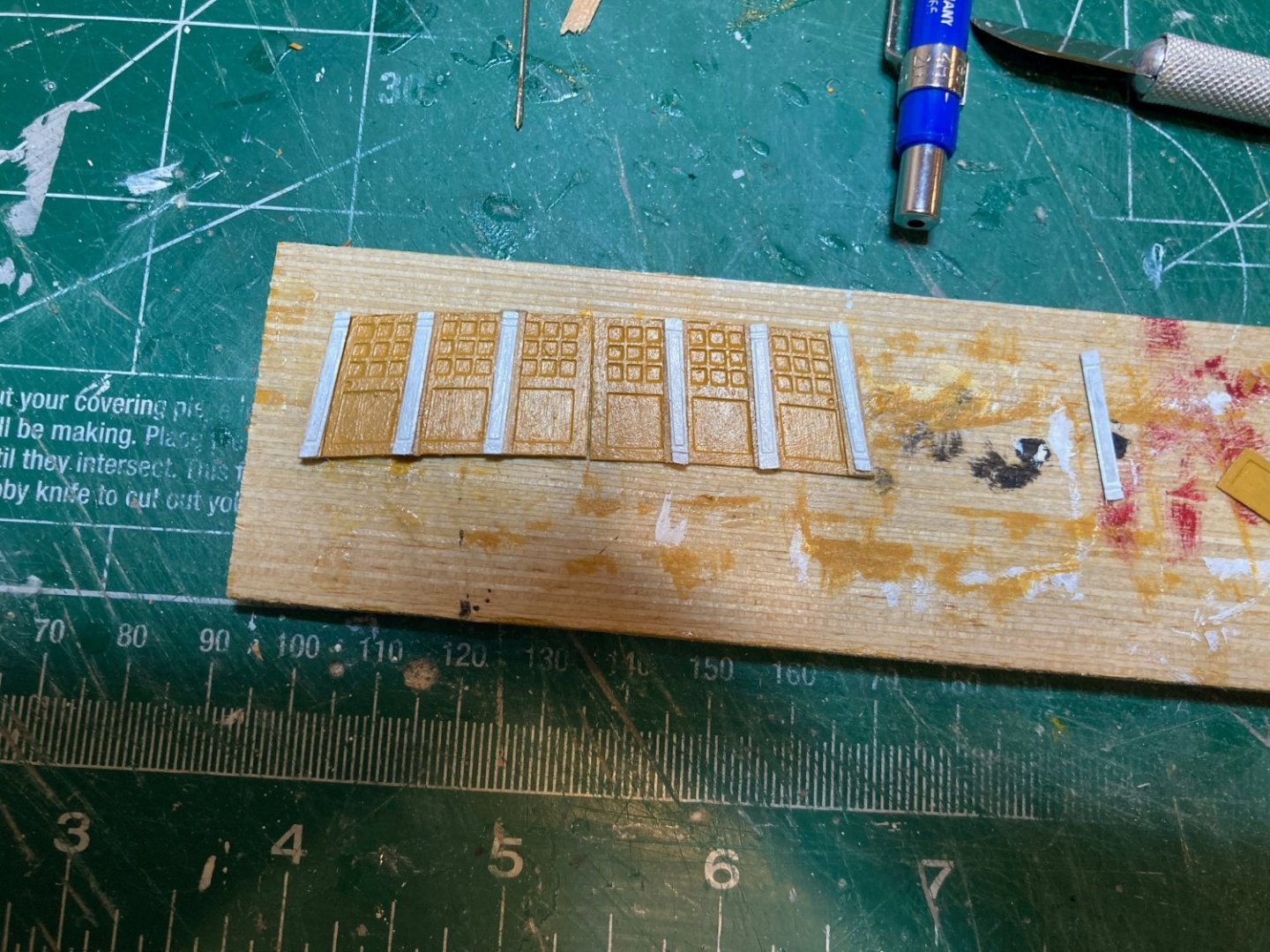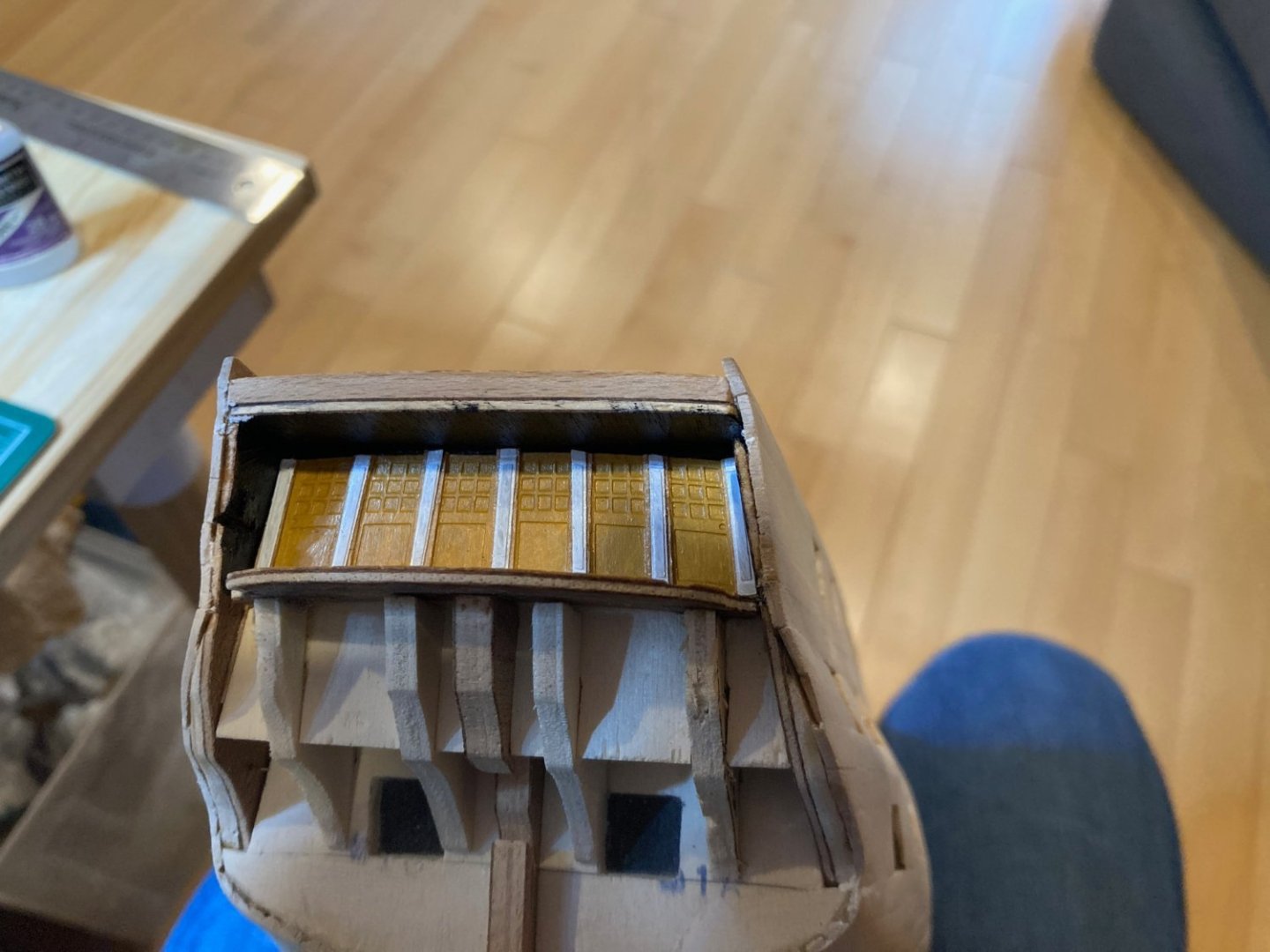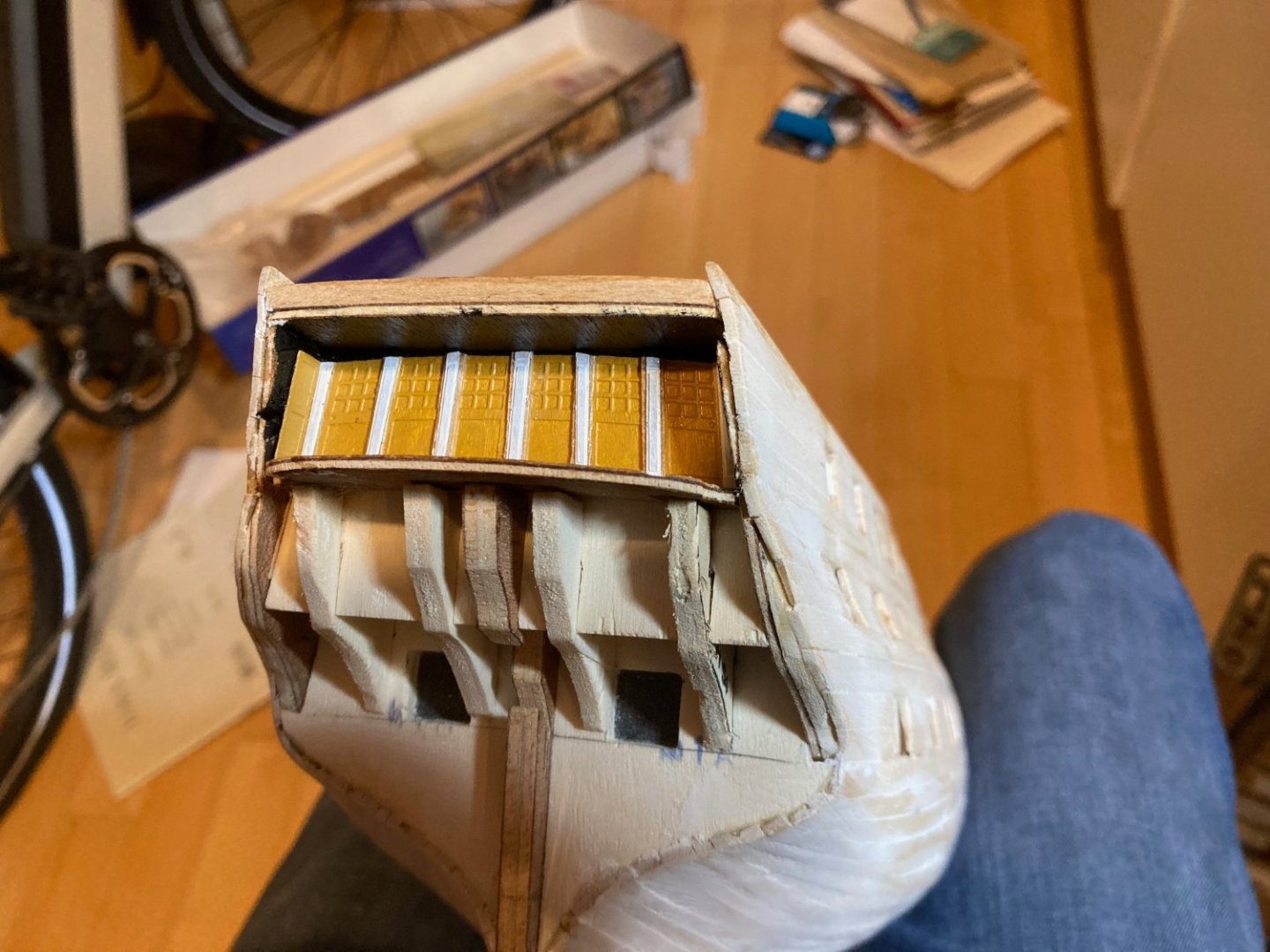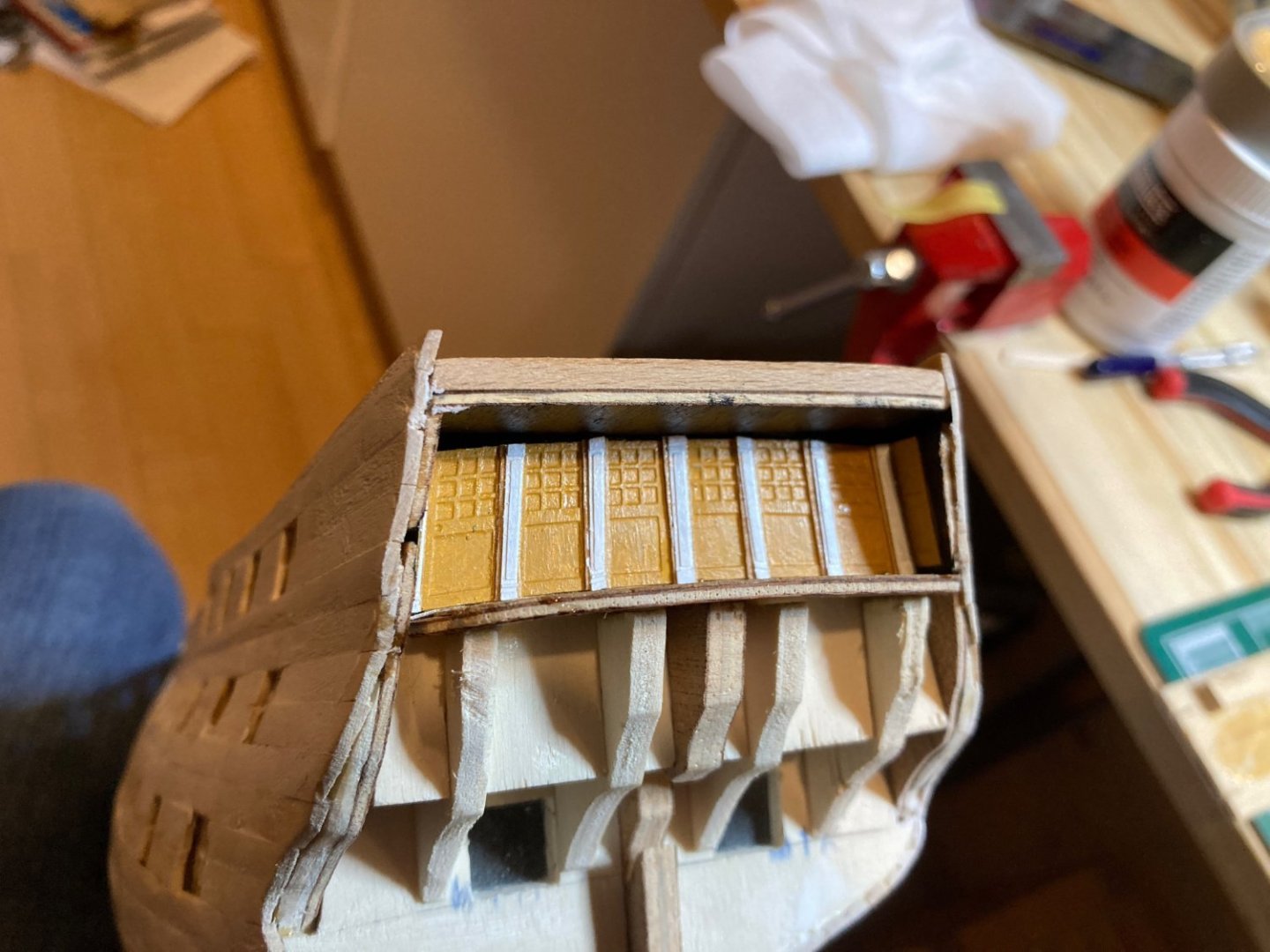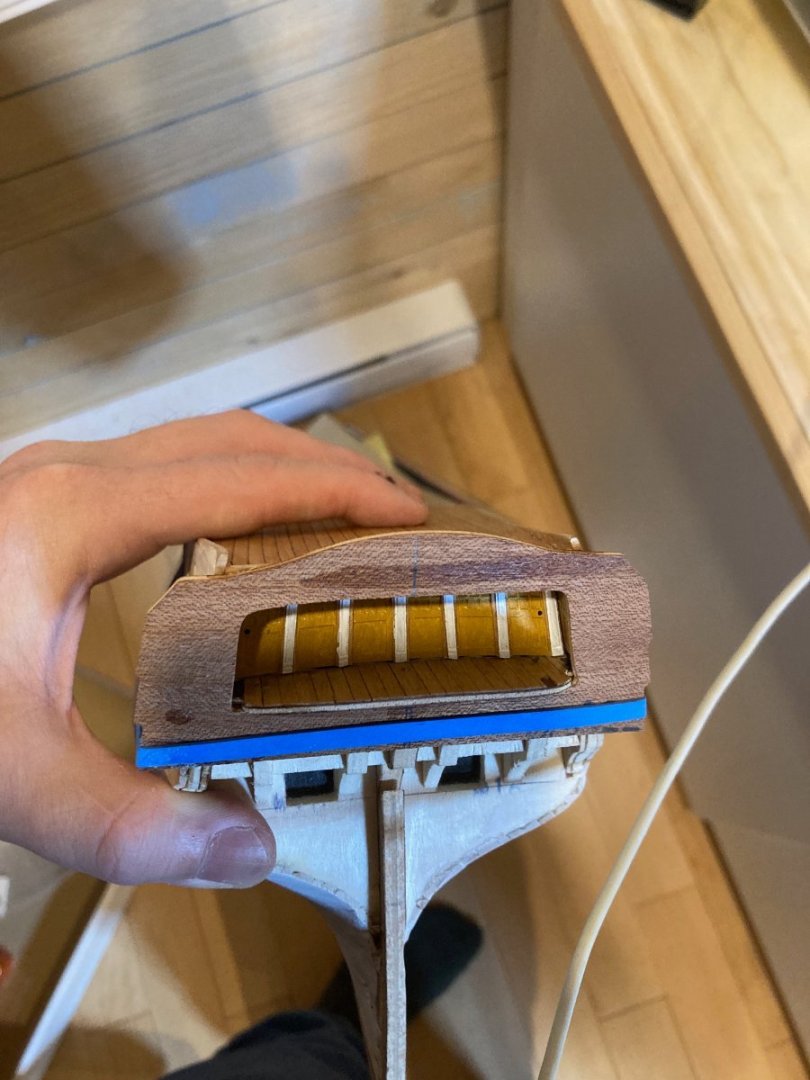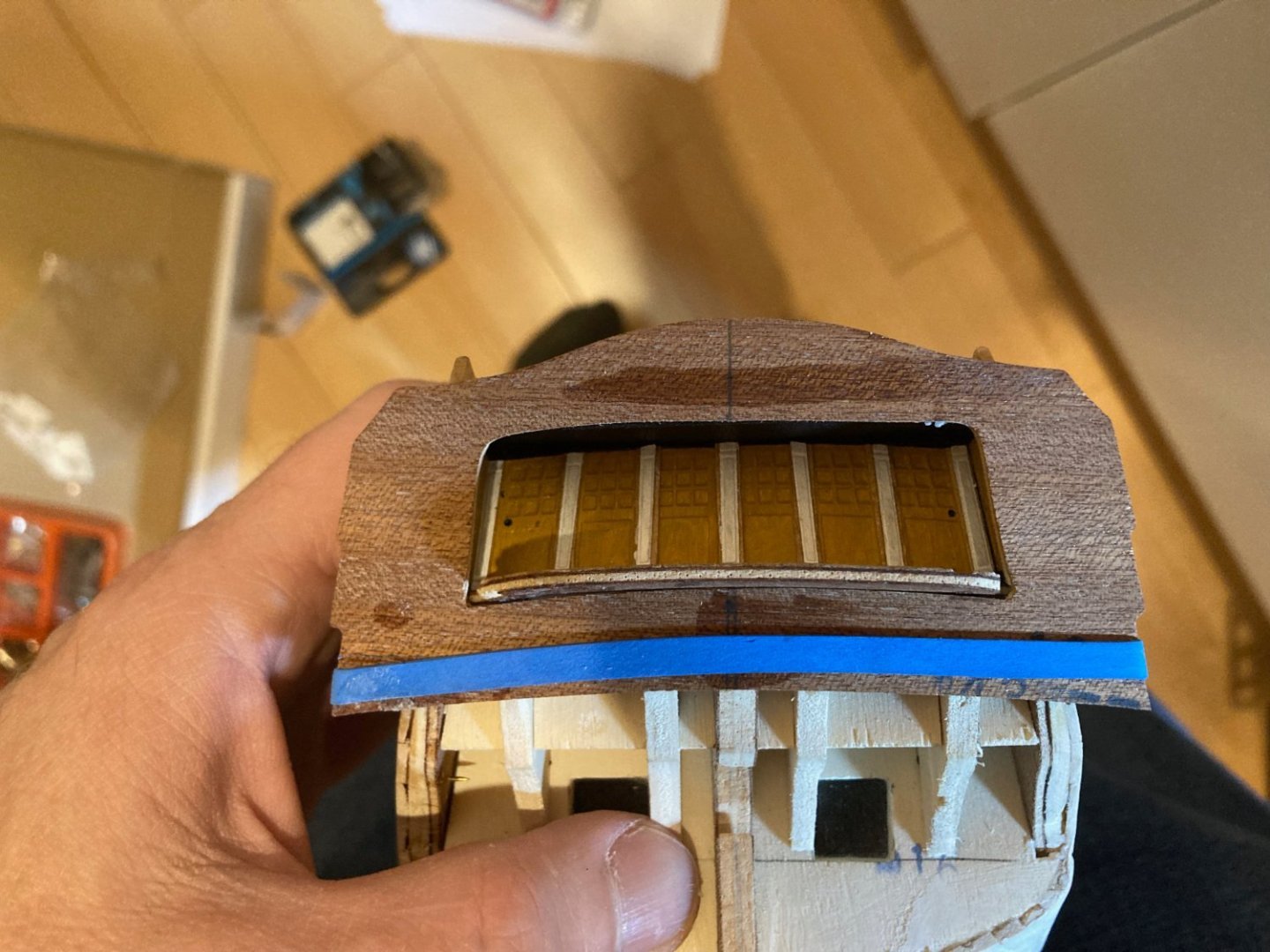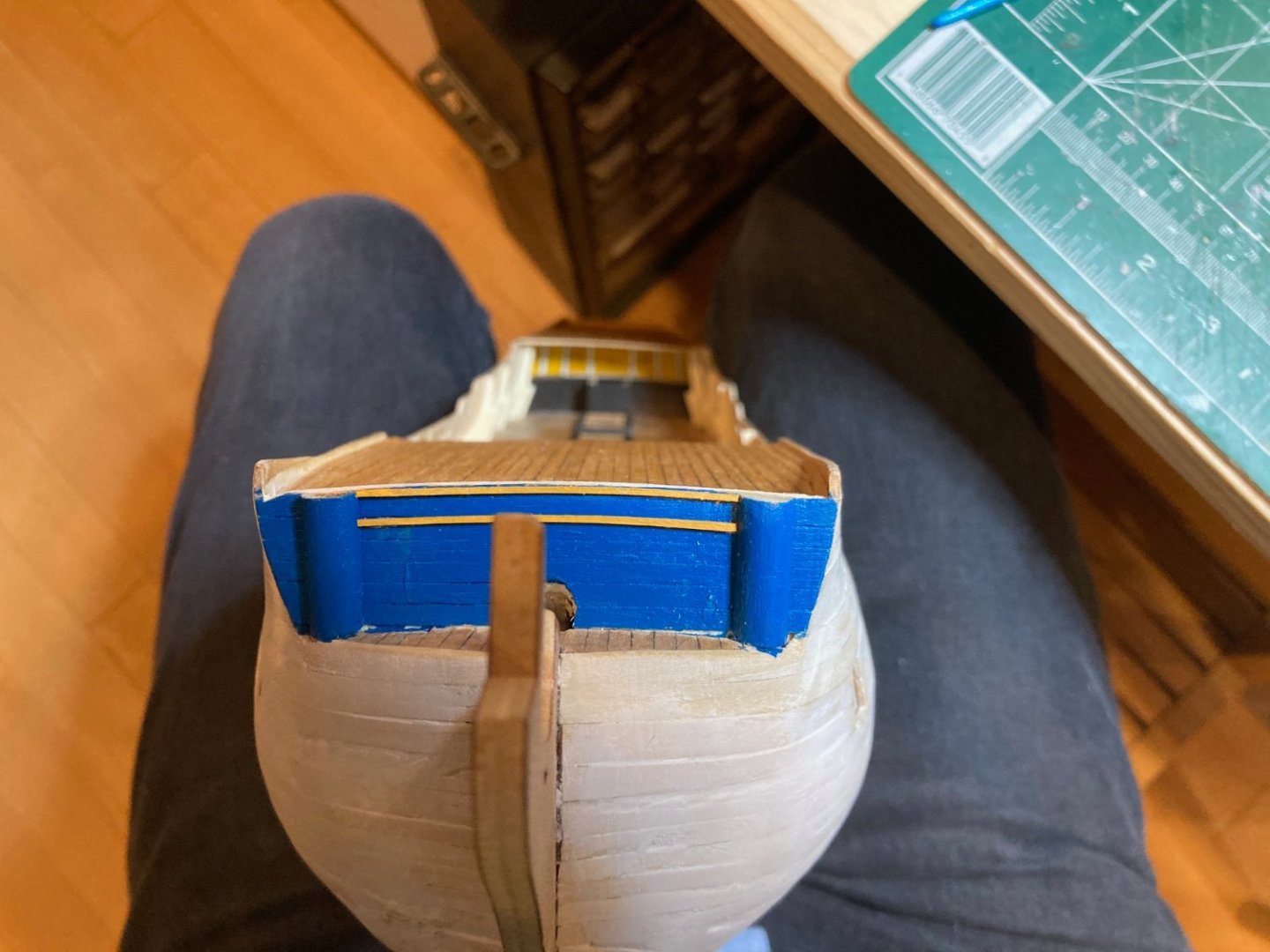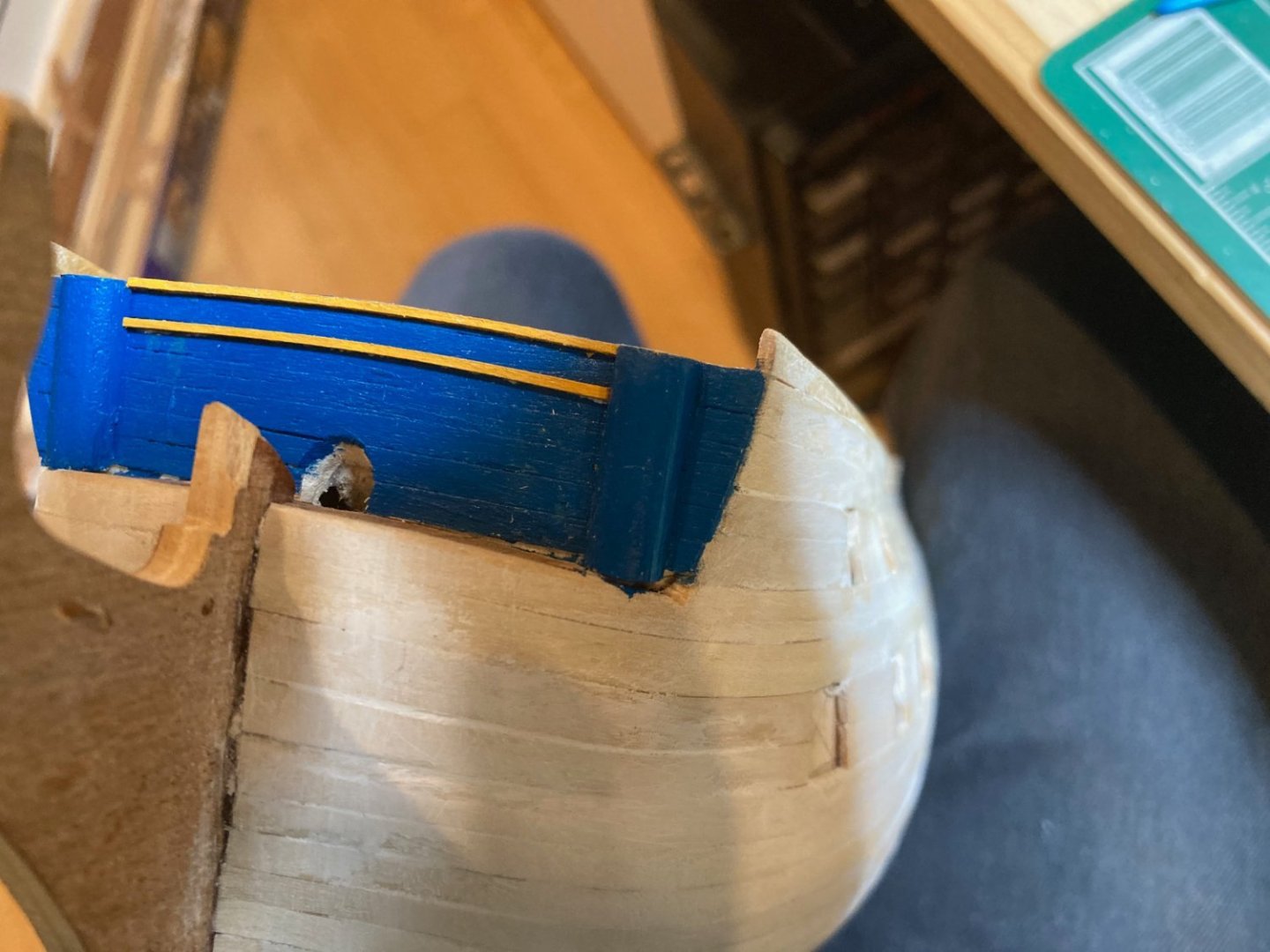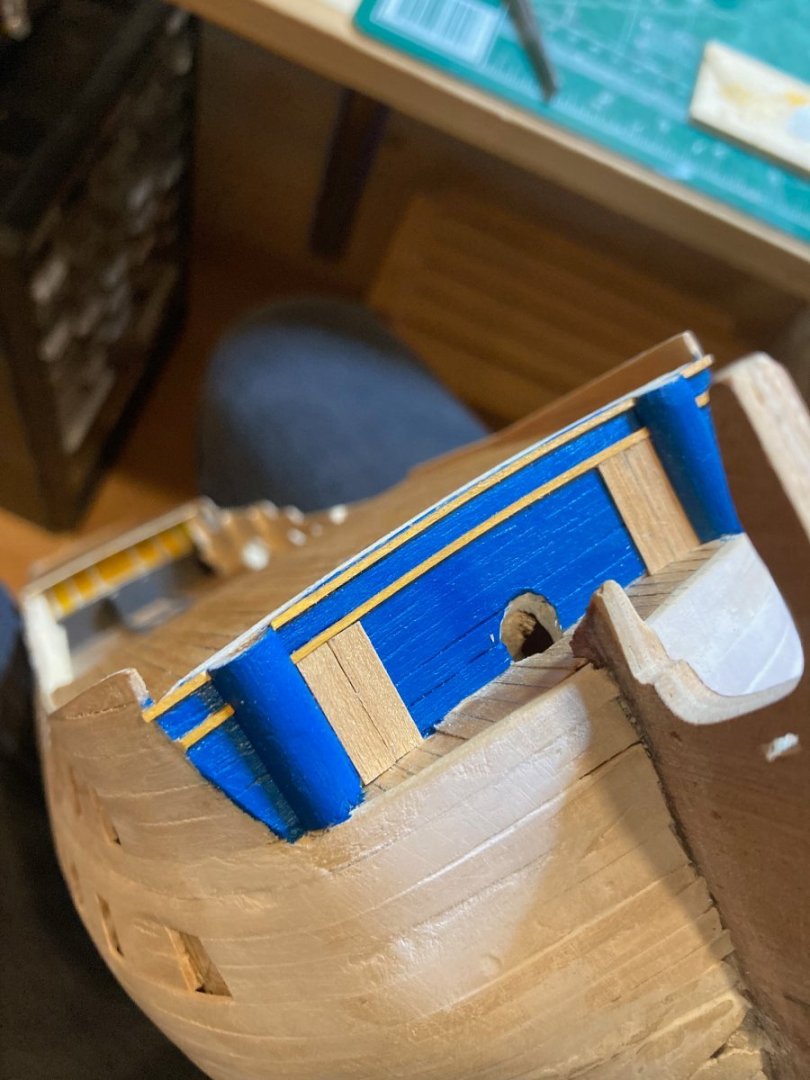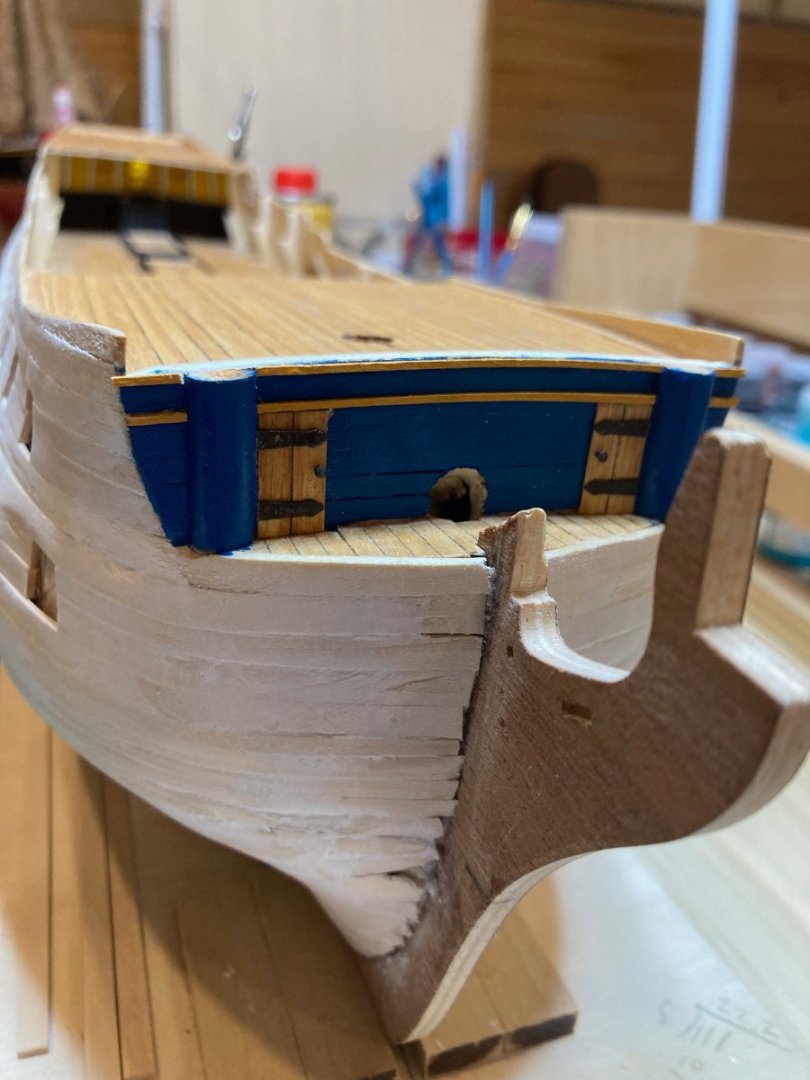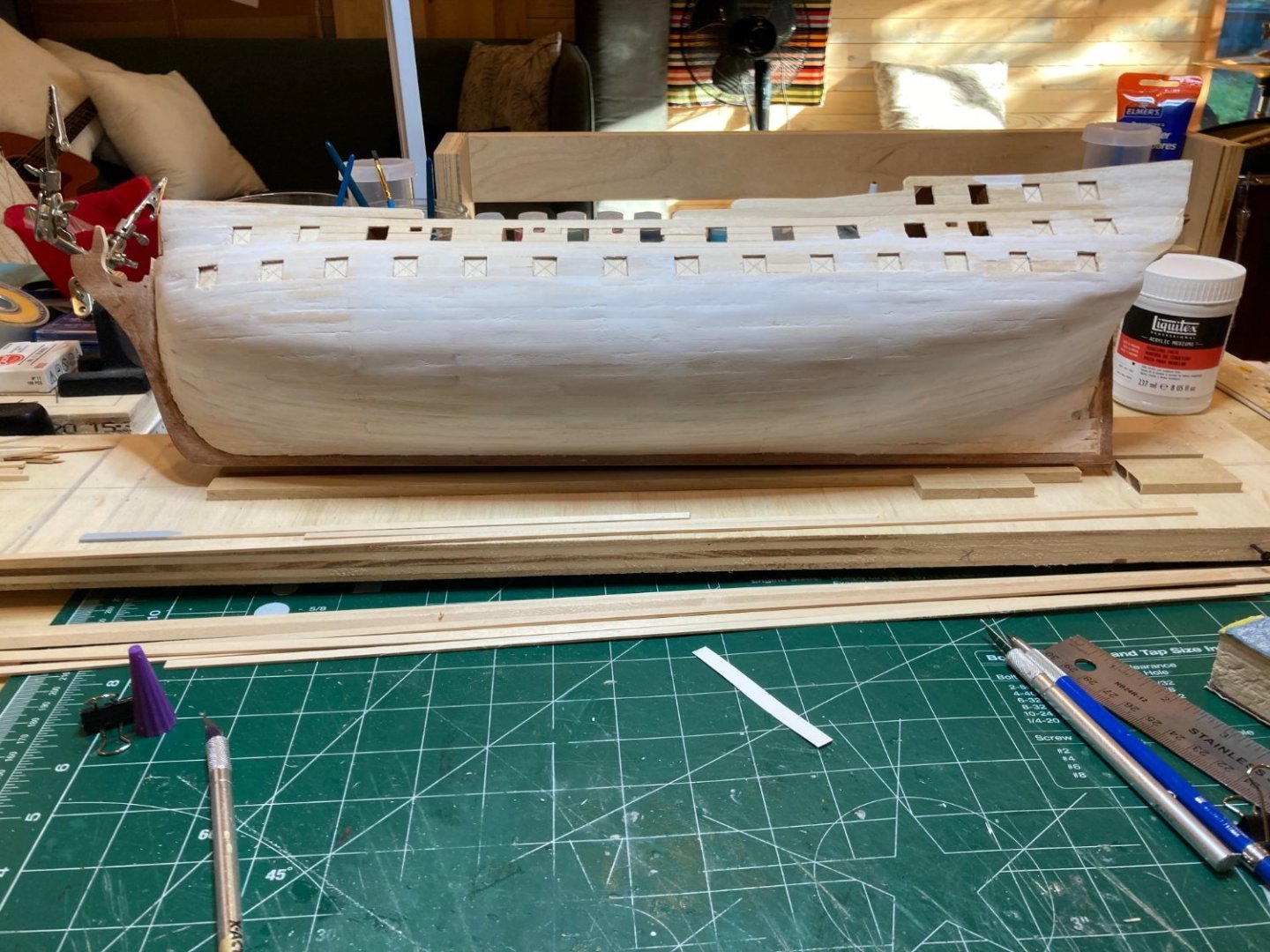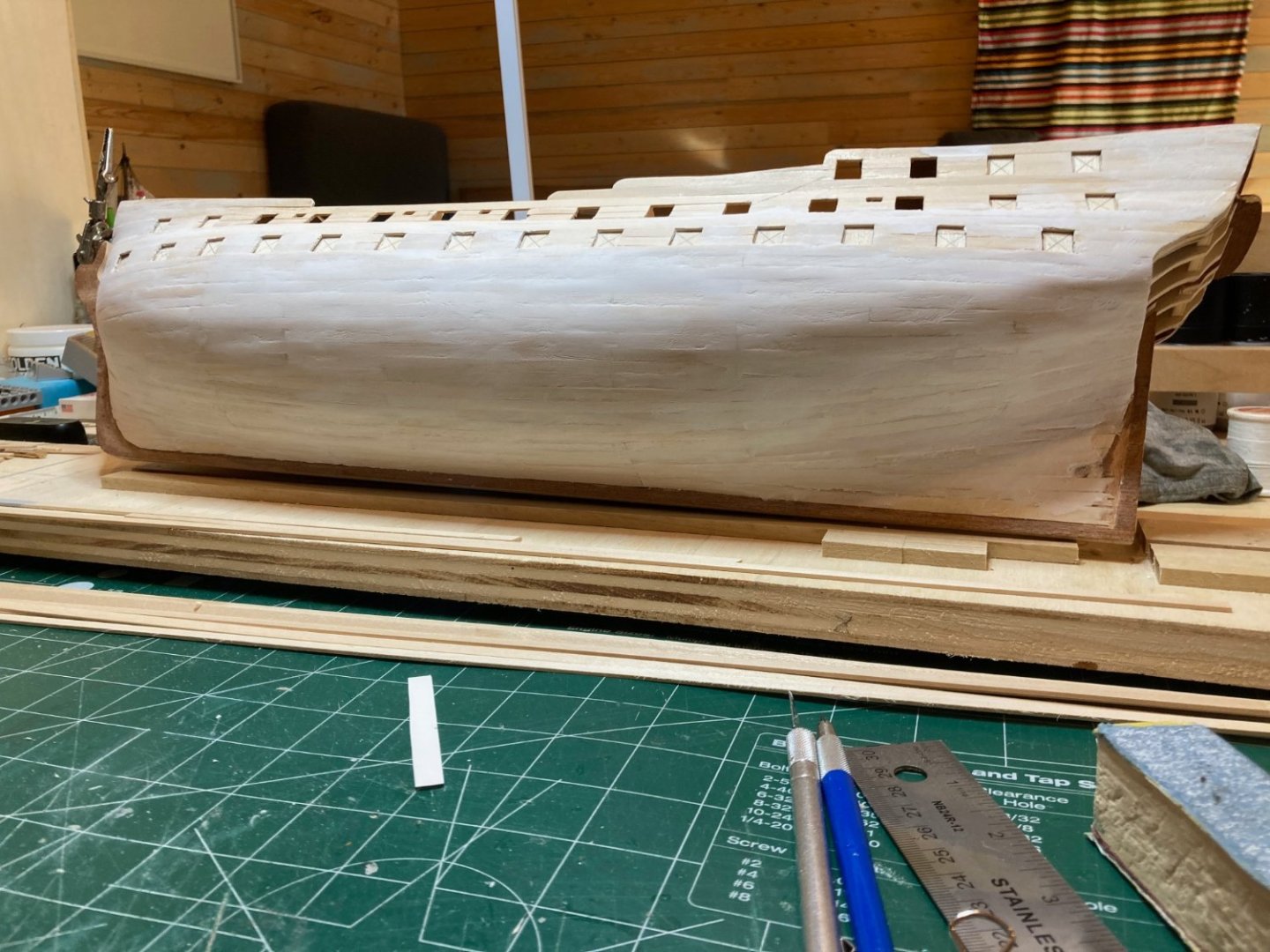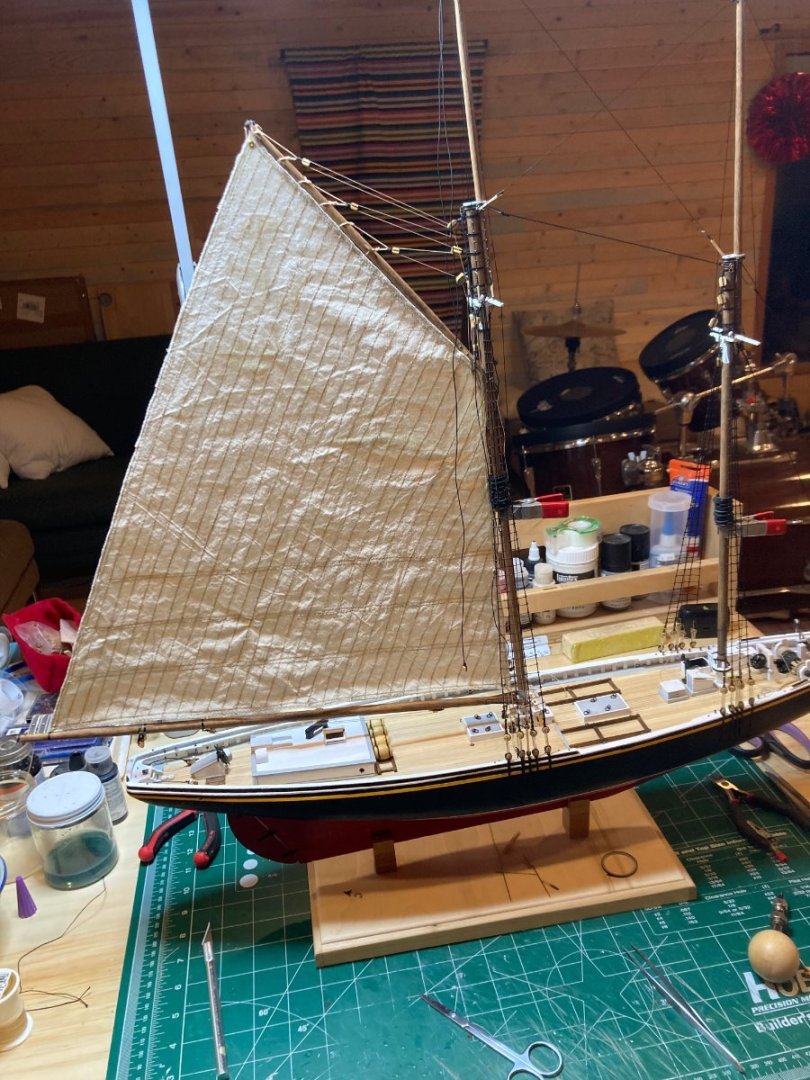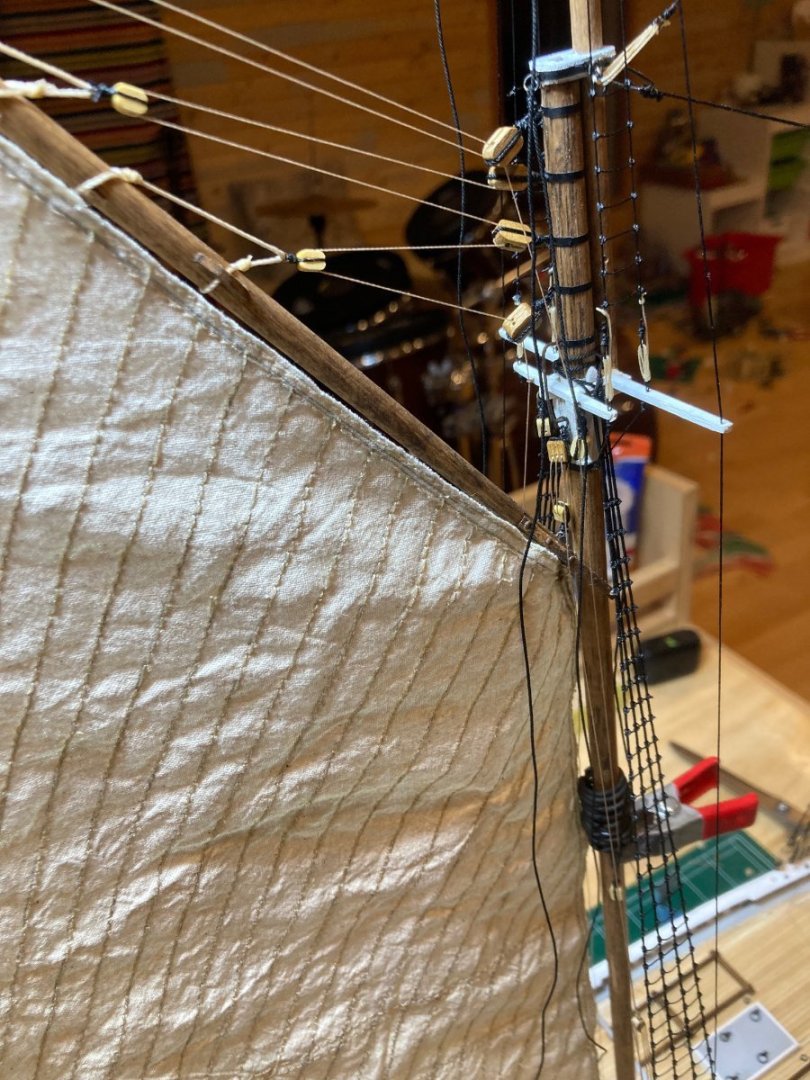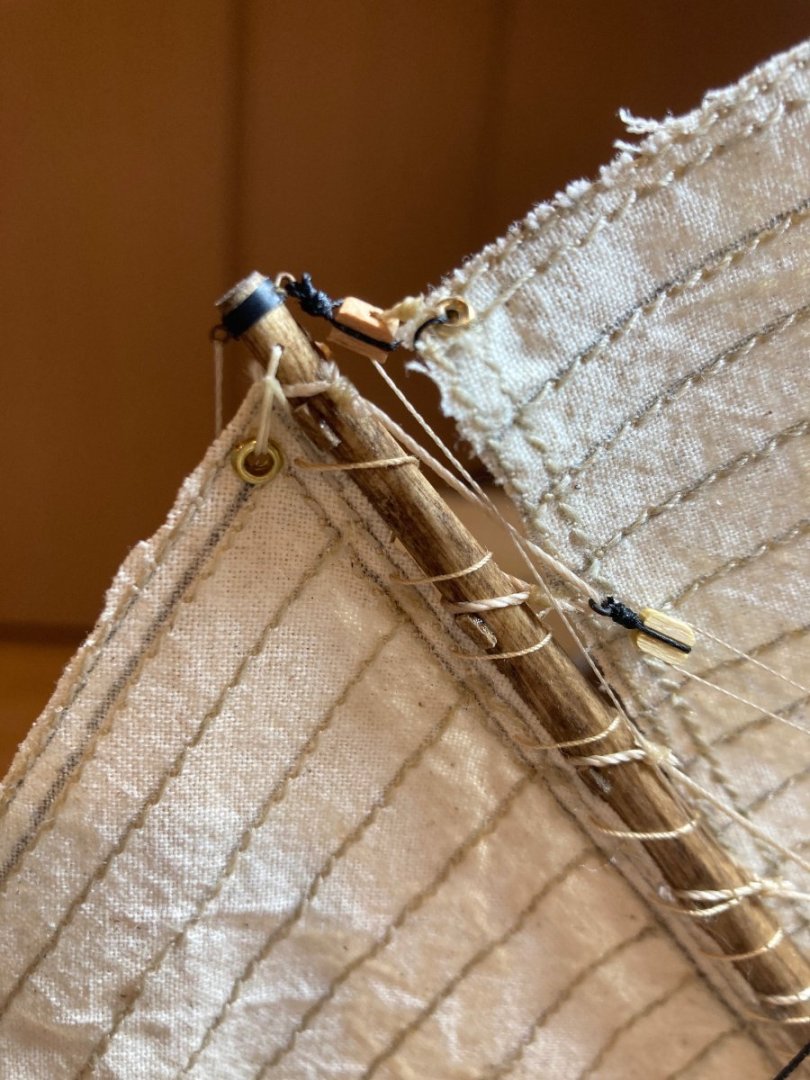-
Posts
1,925 -
Joined
-
Last visited
Content Type
Profiles
Forums
Gallery
Events
Everything posted by hamilton
-
Well - in doing some research into the transom I discovered that I've actually done the stern all wrong!!! Bellona had a tuck stern, as can be seen in Lavery's Anatomy of the Ship, and in several of the build logs here - I took a look at both Yves Vidal's CAF build and Nearshore's Corel build to confirm....But if you look at the photos of the stern above on my build, you'll note that I terminated the lower planking on the edge of bulkhead 19, rather than shaping it as a filler block to define the tuck of the planks at the transom! This is a "square" transom, which can be seen in earlier ship designs....Corel's plans do not make this obvious - though if I was paying attention I probably could have caught this...... I'm not sure what to do about this now - I feel like I have two choices: 1. Continue as is, plank across the square transom and thus deviate in a serious way from Bellona's actual structure; 2. Try to re-do the stern area somehow to correct for my mistake Option one is obviously easier, but I would prefer option 2 - except I have no idea how to alter the stern area now to bring it back into line with the proper planking arrangement.....I could try just sanding the hell out of the stern , but not sure how effective that will be. Adding filler material doesn't seem possible without really throwing the sternpost/rudder arrangement off......arrghhhh!!! Any suggestions will be most welcome..... hamilton
-
Hello there: Work has now started on the transom. I finished the photo-etched bulkhead part in yellow ochre - it comes in two parts with a central pilaster on its tanganyika mount serving to cover the gap between them. Unlike the p-e part for bulkhead 13 on the q-deck, this one fit quite well, with only a roughly 3/64" gap between the two parts when they were fixed to bulkhead 19. There are also two photo-etched doors that are fitten to port and starboard - this leaves a noticeable gap where the framing (painted black) is visible. I'm not sure if there is some subsequent element that covers this gap, or if it is a weird design feature - I'll have to study the plans a bit more to see what's up there.... Attaching the CNC transom was pretty straightforward - just had to mark the centre line for correct positioning and then "clamp" it in place with elastics. Pretty happy with the results so far but I think this work is about to get very complicated and finicky with the quartergalleries, counter planking, etc. Not sure when I'll be able to get back to this in the lead-up to Christmas, but hopefully I can scratch some time out at the bench here and there....in the meantime - enjoy and happy modelling hamilton
-
OK - now that the lower hull planking (lumpy as it looks) is complete I can take a bit of a breather. I've now turned to the beakhead and the stern balcony area before commencing on the second planking. I spent this morning prepping the photoetched parts for the balcony and finishing/adding moldings and doors to the beakhead. I'm still puzzling over how to the bend the 1mm x 1mm moldings around the roundhouses....I'm now wishing that I had added the molding to these half-dowels before installing them in the model....another error in the way I'm staging the build that I'll have to think through..... In any case, here are some photos of the beakhead. Enjoy and happy modelling hamilton
-
Hi Nearshore Just took a look through your recent progress and I have to say your approach to the build is much smarter than mine - I followed Corel's instructions and attached the poop sub-deck before doing the main cabin bulkhead and everything on the quarterdeck, which I'm now realising was a real error....doesn't make it impossible, but definitely makes for a challenge..... In any case, I think your Bellona is looking great - the quartergalleries and transom are shaping up and the planking is coming along well! I'll definitely be looking back here when I get to that stage - hopefully shortly after the new year..... hamilton
-
Thanks Tony! This one's pretty different from Bluenose that's for sure! But just as fun so far.... Harlequin! It's good to hear from you! I get it - I probably have more kits than I need, but I still have hope that I can complete all of them in my lifetime!! I took a long break from modelling - putting in sporadic and minor work from Summer 2017 until Summer 2021 when I built a small (undocumented here) rowing skiff at 1:12 scale. This was meant to get me back into modelling again and it worked! But like with everything, it's often good and refreshing to take a rest - I hope you return to it at some point - but either way, you're always welcome here!! hamilton
-
Looks really good to me! This is one of the easier hull forms to plank I found - much less tapering and spiling involved and since the hull is finished this provides an opportunity to bury any defects of the planking itself. hamilton
- 25 replies
-

USS Constitution by mtbediz - 1:76
hamilton replied to mtbediz's topic in - Build logs for subjects built 1751 - 1800
Very nice and exacting work on the copper plating! hamilton -
OK - it's been very busy at work the last couple of weeks, but we're in a lull now until end of next week, so I'll have a bit of time at the bench til then to make some progress on Bellona. I'm still soldiering on with the first layer of hull planking and in a milestone have now completed the port side, filled and sanded. The starboard side is still in progress with roughly 8 strakes remaining. The planking is pretty rough I haver to say, but it should provide a decent foundation for the second layer, which I'll pursue with more care and sensitivity to the results! My goal is to finish the first planking tomorrow and then move on to the beakhead, stern area and quartergallery framing, which I'm both very excited about and pretty intimidated by....but we'll see how it goes! Not much in the way of interest in the photos, really, but here they are hamilton PS - to the right in the background in the first photo, you'll see the filler product I use - Liquitex acrylic modelling paste. It is really a wonderful product (I have no association with the company at all) - it is a medium thickness almost like light cake icing, but it dries incredibly hard and sands down to a very fine eggshell finish. It also takes both paint and adhesive really well, which is a nice bonus. h.
-
Thanks for your response Chris! Yes I understand - but it's not about a version of the vessel - it's about specific kits that are desirable to build and that create real excitement among the modelling community - yours and Chuck's fall squarely into that category. No offence to Panart, but the Victory you designed just seems better in every respect. I don't necessarily want to build "a" Victory, but I definitely want to build your Victory, if that makes sense. The economics of kit manufacture are unfamiliar to me, so I would never presume the circumstances you face in developing and maintaining your business. That's not what the issue is. It's more that perhaps some business innovation - like Chuck's with the Winnie & Cheerful broken into chapters, or CAF's with their line - will be helpful at sustaining this craft for a broader cross-section of the ship model market. $500.00 is about my limit for a kit - about the price of Chapter 1 of CAF's Granado. I imagine others set their sights similarly or lower. If the Victory or other high end kits were presented in modules, I imagine way more people would buy them and manufacturers could tap into markets for their products that otherwise represent unrealised demand. It requires some innovation and re-thinking on the manufacturer's side, but once that's done..... It's kind of like when the Bell phone company originated, they though that their business model would involve selling expensive devices and connection services to the wealthy - niche product, small market, high price point. Bell (well....Alfred Vail) figured out that the value of their network was based on volume of connectivity - so there was good business sense in expanding the network and lowering the cost of service to facilitate this - a move that led to massive profits for Bell and put them in the catbird seat for network development for a sustained period of time. I believe you, Chuck, CAF are in that position now, representing younger and more innovative entries into the manufacturer's market with an opportunity to refresh things overall - think of the number of kits you have developed in the last 2 years relative to what Caldercraft/Jotika has introduced in the last 2 decades....that says a lot, I think, about market position and market potential. People are excited about your kits and Chuck's too, and this community provides an active following that serves direct promotional functions. It's a great situation! But it could be even better! The idea of the high-value product for the niche modelling market is fine, but there is still money to be made outside of that market with the same product through a different organisation of the manufacture and presentation of the kits. Admittedly I have no idea how offering kits in sections/chapters might affect the cost of manufacture - obviously a big concern - or even if it is a realistic approach to design....but it seems something worth exploring more generally as a means of sustaining the craft and the businesses on which it depends. The modular nature of ship modelling itself also supports this approach. Full disclosure - I'm a philosopher by trade and not an entrepreneur, so my comments here come from a pretty idealised conception of how to run a ship model business - or any business! But at the level of accessibility and market development, it seems to make sense to offer avenues of access that can realise the value of the ship modelling market more fully than the complete high-end product can or does. I hope these remarks are not taken in any way as a slight against any kit manufacturer's practices! More the observations of an envious modeller dreaming of a different world..... hamilton
-
Feel like it's more of an educated guess, based on the price of the Vanguard Indy, which at today's exchange rate would set me back $2300 CDN....a desirabe kit, beautifully constructed and well out of my grasp. hamilton
-
Hi Tim - not sure how I missed this log during my BN build....your work is excellent! Very nice results. I'm always impressed by those who, like you, can pull off such nice metal work at this scale! hamilton
- 145 replies
-
- Bluenose
- Model Shipways
-
(and 1 more)
Tagged with:
-
Hello again Helmar: Here is a link to a thread here on MSW that has some images of a seizing process - not the same one I use, but with better results! Hope this can help, too if that's the kind of help you're looking for.... hamilton
-
Hello Helmar: Are you talking about the blocks on the gaff for the main peak halliard (photo below)? If so, you need to attach 3 slings to the gaff, which are held in place by small wooden chocks attached slightly to port and starboard on the bottom of the gaff (as shown on the plans). The peak halliard blocks are then seized onto these. My approach was to first seize a length of tan rigging thread to the gaff by the pair of chocks at the end of the gaff (the seizing should be on the outward side of the chocks so when the halliard is tied on the sling gets pulled snugly against the chock and held in place) - I used lengths that are much longer than required as this makes the process easier. Once that was on, I ran a small blackened brass ring onto the sling (this was used to seize the halliard block onto), and then looped the other end around the gaff at the next set of chocks towards the mast (again, on the outward side for pressure), seized this loop and then pulled the loose end of the sling through the seizing until it was a reasonable size, then sealed the seizing with a bit of diluted wood glue. This process was repeated two more times for the other slings on the main gaff. To rig the blocks, I seized them to the brass rings on the gaff slings. The halliard runs from deck-level on one side through the blocks on the mast and the gaff and ends in a tackle on the other side as per the plans. It is very difficult to describe in words alone how to do this....There may be a topic thread in the rigging section of MSW that shows how to do some basic operations - like stropping blocks and seizing lines. I know I was deeply confused about these terms when I started modelling. Hopefully this descriptive account can help a bit.... hamilton
-
I really hope Amati considers releasing this in chapters like CAF's models.....this would make it more accessible to those of us who model on a limited budget! I'm guessing the retail price on this kit will be around $2000....not a realistic prospect for many, myself included.....with many desirable kits priced so highly (and understandably given rising costs of materials, particularly wood), it makes good business sense to widen the market by providing a more modular approach to building....but that may just be my view from the cheap seats..... hamilton
-
Missed your last question from your latest post....I use a scalpel blade to shave off thickness of the planks where they buckle out from one another and then sand them as smooth as possible. I also use (as many do) healthy doses of wood filler (actually I use acrylic modelling paste, which I find to be a very good product for this purpose) will help with any cracks or seams and then more sanding. Is this a double-planked hull? I can't recall from when I built it, but I thought it was only single planked.....In any case, on this model it isn't necessary to get a pristine planking job on the hull - unless you don't plan on painting it. Once you fill and sand the planks and paint them, you will not see any of the imperfections of the planking itself. hamilton
- 25 replies
-
I built this kit over a decade ago so my memory is foggy, but the cutwater you refer to above is to be added along the keel edge forward - you need to leave a gap in the planking from the bottom of the keel (horizontal section) forward and then add the cutwater as a strip between the plank-ends once the planking is complete. I hope this helps with your first question. As for question 2, I'll be honest and say I haven't read the other members' responses, so I may be repeating here, but I believe this is just to ensure consistency in its width after you plank the hull. This part of the build was, I recall. confusing for me too as it wasn't clear whether I was supposed to plank over the keel all the way to its base or only to the bottom of the bulkhead frames. I believe I planked only to the bottom of the frames to maintain the width of the laser cut keel and not thicken its width by planking over it....I also hope this response is clear.... This was a fun build as I recall, and I think it's a good one for getting into the hobby as long as you keep in mind that the rig on this one is quite a bit simplified from the actual vessel (good for learning the basics) and that the small scale sometimes makes it a bit tricky. But if you approach it as a learning experience, then you can start to hone skills that will help with the next one. Have fun! hamilton
- 25 replies
-
Looking great Greg! Nice work on the catheads and the fore deck looks nicely arranged! hamilton
- 184 replies
-
- Bluenose
- Model Shipways
-
(and 1 more)
Tagged with:
-
Yes - the Santa Claus approach (making a list and checking it twice) is to be advised at this point - I definitely found that I'd missed a couple of things that it would have been better to add earlier at this stage - the rig is shaping up for you now, though John! Looks great - can't wait to see the next phase hamilton
- 282 replies
-
- Bluenose
- Model Shipways
-
(and 1 more)
Tagged with:
-
Could be a generational thing, Chuck. The more younger members join - which is to be encouraged to keep the craft going for future generations - it's probably to be expected that some of the broader elements of digital culture are going to creep in.....MSW - like most web forums - is old school internet, where it takes human beings to set up and enforce community standards. This is how the whole thing was when I first went online as a teen in the mid-1980s, when the NSF was still running the show. But most folks (young and old) have gotten used to a world where "moderation" has largely been automated through SEO algorithms and algorithmic news feeds, so I don't think there is as clear an understanding of the human labour that goes into managing a site like this and keeping its quality as high as it is. But it doesn't help if users treat the forum as if it were Facebook or "Twitter", where these kinds of posts have literally 0 impact on the management of the platform itself. If I had more time between my young family and my work I'd love to chip in to help with moderation here - I'll reach out once I can afford to retire - in 2043!!!! Waaahhhh!!! hamilton
About us
Modelshipworld - Advancing Ship Modeling through Research
SSL Secured
Your security is important for us so this Website is SSL-Secured
NRG Mailing Address
Nautical Research Guild
237 South Lincoln Street
Westmont IL, 60559-1917
Model Ship World ® and the MSW logo are Registered Trademarks, and belong to the Nautical Research Guild (United States Patent and Trademark Office: No. 6,929,264 & No. 6,929,274, registered Dec. 20, 2022)
Helpful Links
About the NRG
If you enjoy building ship models that are historically accurate as well as beautiful, then The Nautical Research Guild (NRG) is just right for you.
The Guild is a non-profit educational organization whose mission is to “Advance Ship Modeling Through Research”. We provide support to our members in their efforts to raise the quality of their model ships.
The Nautical Research Guild has published our world-renowned quarterly magazine, The Nautical Research Journal, since 1955. The pages of the Journal are full of articles by accomplished ship modelers who show you how they create those exquisite details on their models, and by maritime historians who show you the correct details to build. The Journal is available in both print and digital editions. Go to the NRG web site (www.thenrg.org) to download a complimentary digital copy of the Journal. The NRG also publishes plan sets, books and compilations of back issues of the Journal and the former Ships in Scale and Model Ship Builder magazines.


